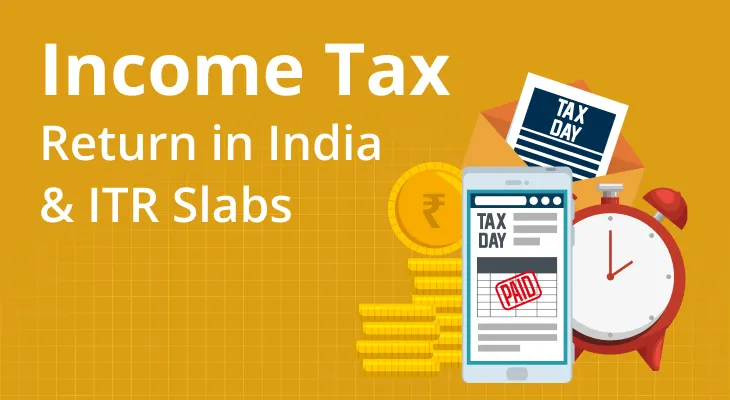
File Income Tax Return in India
In the growth of our nation, your role as a responsible citizen is vital. Within this journey, income tax is a significant aspect. As per the regulations outlined in Indian income tax laws, the filing of an IT return is a requisite for eligible individuals and businesses with income for the year. This process aids in the acknowledgement of taxable income, determination of tax obligations, and assertion of claims for applicable tax deductions.
This blog aims to guide you on how to file an income tax return in India, ensuring confidence and reducing stress.
What is Income Tax Return Filing?
Filing an Income Tax Return (ITR) in India is a crucial process for residents with an income. It involves sharing a transparent overview of your earnings and taxes with the government. Consider it as a formal declaration of your financial activities. This data aids the government in calculating the correct amount of tax you owe, contributing to the nation's growth. Filing an ITR involves reporting your income sources, eligible deductions, and total taxes paid. This ensures compliance with tax regulations and accurate payment. Beyond tax collection, the government utilises this data to make informed decisions about budgets, development initiatives, and policies.
In essence, ITR filing is your responsible contribution to the country's progress. It showcases your commitment to being a law-abiding citizen and supports the nation's development endeavours.
Types of Income Tax Return
Indian Income Tax Department provides a wide range of ITR forms, each designed to cater to specific categories of taxpayers. The essence of an accurate tax declaration lies in selecting the appropriate form. Here are some of the commonly used ITR forms:
ITR 1 Or Sahaj
Tailored for individuals with income originating from salary, a single house property, or other sources. This form is suitable for those whose total income remains under Rs. 50 lakhs.
ITR 2
Designed for individuals and Hindu Undivided Families (HUFs) who don't derive income from business or profession, and for those who possess multiple house properties and income from diverse sources.
ITR 2A
This recently introduced form for filing income tax returns in India, is specifically designed for individuals and HUFs. It applies to those with salary income, ownership of multiple house properties, and no capital gains income.
ITR 3
Crafted for an individual taxpayer or a Hindu Undivided Family (HUF) member who is a partner in a firm but doesn't engage in any business activities through the firm. This also pertains to individuals not earning any income from the firm's operations.
ITR-4 Or Sugam
For an Indian resident individual, HUF, or a partnership firm earning income from a profession or business, choosing ITR-4 is a must. However, this option isn't available for Limited Liability Partnerships (LLPs).
ITR 5
Tailor-made for firms, Association of Persons (AOPs), Body of Individuals (BOIs), and Limited Liability Partnerships (LLPs).
ITR 6
Aligned with companies not availing exemption under section 11 of the Income Tax Act.
ITR 7
Intended for individuals, including companies, filing under sections 139(4A), 139(4B), 139(4C), 139(4D), 139(4E), or 139(4F)
Who Should File Income Tax Returns in India?
Individuals who earn a combined income from various sources exceeding the exemption limit are required to submit their income tax returns. This norm applies universally to individuals, HUFs, companies, and other entities. Moreover, if you're a Non-Resident Indian (NRI) with income that's subject to tax in India, it's your duty to submit an income tax return within the country.
Process for ITR Filing
Filing your Income Tax Return (ITR) might seem like a complex task, but breaking it down into simple steps can make the process smoother. The steps mentioned below will help you navigate this process:
Collect Essential Documents
Gather important documents such as your PAN card, Form 16 from your employer, Aadhaar card, investment proofs, bank statements, and any other relevant financial documents.
Select The Correct ITR Form
Depending on your income sources and financial situation, choose the appropriate ITR form. Each form is designed for specific types of taxpayers, so make sure to pick the one that fits your profile.
Calculate Your Income
Calculate your total income for the financial year. Include your salary, business income, rental income, and any other sources of income.
Calculate Taxable Income
After calculating your total income, deduct eligible deductions such as under Section 80C (for investments like Provident Fund, Life Insurance, etc.), Section 80D (for health insurance premiums), and others to arrive at your taxable income.
Compute Tax Liability
Use the applicable ITR slabs and rates to calculate the tax you owe on your taxable income. You can also take advantage of available tax credits and rebates.
Fill In The ITR Form
Carefully fill in the details in the selected ITR form.
Review And Verify
Before submitting, review your ITR form to ensure accuracy and completeness. Verify all the details to avoid errors.
Choose E-Filing Or Physical Submission
You can choose to e-file your ITR on the Income Tax Department's official website or submit a physical copy to the designated ITR receiving offices. Electronic filing is more convenient and faster.
E-Verify Or Send ITR-V
If you e-file your ITR, you can verify it electronically using options like Aadhaar OTP, net banking, or EVC. If you choose physical submission, you need to send the ITR-V form to the CPC within 120 days.
Keep Records
Maintain copies of all the documents, including the filed ITR, acknowledgement, and supporting documents. These records will be valuable for any future references.
ITR for NRIs (Non-Resident Indians)
For NRIs, filing income tax returns in India follows some specific guidelines:
Check Your Income
NRIs need to file ITR if their income in India crosses the exemption limit. As a Non-Resident Indian (NRI), you are entitled to a basic exemption of ₹2,50,000 on your total income in India. However, this exemption does not apply to short-term or long-term capital gains.
Types Of Income
Any income earned in India – like rent or investments – should be considered for tax calculation.
No Aadhaar Requirement
While Aadhaar isn't mandatory for NRIs, linking it with PAN is advised.
Easy Online Filing
NRIs can file ITR online using the Income Tax Department's website.
Pick The Right Form
Choose the ITR form that fits your income sources, like ITR-2 for salary, house property, or capital gains.
Bank Details
Share your bank account details for potential tax refunds.
Calculate Taxable Income
Deduct expenses, deductions, and exemptions from your total income.
Filing Deadline
If no audit is needed, ITR is usually due by July 31st. But dates can change, so stay informed.
Expert Help
For complex situations, consulting a tax professional familiar with NRI taxation is smart.
By following these steps, NRIs ensure their ITR filing is accurate and compliant, contributing to India's progress.
Due Date for ITR Filing and Penalty for Late Submission
For most taxpayers, this significant point arrives on July 31st of the assessment year. Nonetheless, it's imperative to stay updated on any government updates that might alter this timeline. If you do not meet the deadline, it could lead to penalties ranging from Rs. 1,000 to Rs. 5,000, based on the extent of the delay.
Common Mistakes & How to Avoid Them
Filing your Income Tax Return (ITR) accurately is crucial to avoid delays, notices, or even penalties. Here’s how you can steer clear of them:
- Selecting the Wrong ITR Form
Choosing an incorrect form, such as filing ITR-1 when you have capital gains income, can result in defect notices and processing delays. Always verify your eligibility before selecting the form. - Wrong Assessment Year or Tax Regime
Filing under the wrong assessment year (for example, using the wrong AY for your FY) or choosing the wrong tax regime can cause substantial difficulties with calculations and processing. - Skipping Verification of Form 26AS/AIS
Failing to reconcile tax credits and incomes with your Form 26AS or Annual Information Statement (AIS) may cause mismatches, notices, or refund delays. Therefore, you must always cross-verify the data. - Mistakes in Bank or Personal Details
Errors in bank account numbers, IFSC codes, or PAN details can delay your refund or cause outright rejection. It is important to double-check these details before submitting. - Failing to Report All Sources of Income
You must report income from every source, not just your primary earnings. This includes interest from savings accounts or fixed deposits, rental income, capital gains, and exempt income. Omitting these, knowingly or unknowingly, can lead to issues.
By avoiding these common pitfalls, ensuring correct form selection, reconciling income and tax data, and verifying your personal banking details, you can significantly improve your filing accuracy and reduce the chances of complications.
Conclusion
Filing an Income Tax Return in India represents a concrete contribution towards the nation's progress, coupled with adherence to the legal requirements. Grasping the diverse spectrum of ITR forms, the corresponding eligibility parameters, and the process of filing itself, can transform this complex endeavour into a manageable task. By carefully following the step-by-step guide and respecting the due date, you're not merely fulfilling your responsibilities but actively participating in strengthening the nation's infrastructure. Understand your role as a responsible taxpayer, and fulfil the task of filing your ITR diligently, recognising the crucial role you play in shaping a brighter future for India.
An Income Tax Calculator helps you estimate how much tax you need to pay based on your income, deductions, and exemptions. Use our Income Tax Calculator to understand your tax liability better and plan smarter to save more.
FAQ
What Notices Should I Expect After Filing ITR in India?
Depending on the differences detected, you may get alerts for mismatched information, underreporting income, inadequate returns, scrutiny evaluation, or failing to e-verify after completing your ITR.
What is the last date to file ITR for FY 2024-25?
The deadline for filing ITR for FY 2024-25 is July 31, 2025, unless the government extends it. If you miss the deadline, you may have to pay a late filing charge.
How can mStock assist me with my ITR filing?
m.Stock simplifies ITR filing by offering guided assistance, accurate tax computation, error-free filing, and e-verification support, ensuring compliance with deadlines and avoiding common mistakes while maximising deductions.
Can I file my ITR after the due date?
Yes, you can file a belated return after the due date by paying applicable late filing fees under Section 234F. However, certain benefits and deductions may not be available.
Can income tax returns be filed after the due date?
Yes, they can. However, it's important to be aware that filing post the due date leads to penalties and interest, even though such filings are allowed within the assessment year
How to check the income tax return status?
Checking the status of your ITR is a straightforward process, requiring a few clicks on the Income Tax Department's official website. By entering your PAN and the relevant assessment year, you can quickly access this information.
What documents are required to file ITR?
The essential documents include a PAN card, an Aadhaar card, bank statements, Form 16, proof of investments, and comprehensive details of income from all sources.


